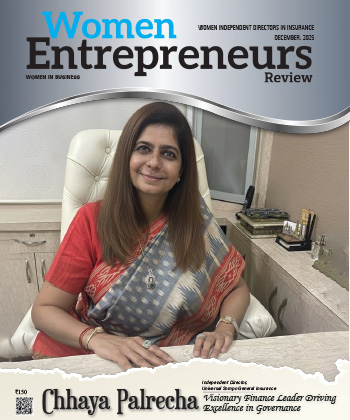
AI, Agility & Accountability: The Future of Compliance in a Shifting Regulatory Landscape
By: Shraddha Shah, CS, Whole Time Director & Compliance Officer, JSI Investments (Jane Street India)
With two decades of experience in the Indian capital markets, Shraddha brings a global perspective shaped by roles across major financial hubs including Singapore, Hong Kong, London, and New York. Her expertise spans regulatory advisory, governance, AML, KYC, sanctions, and private equity transactions.
In an insightful interaction with Women Entrepreneurs Review Magazine, Shraddha shares her insights on how banks in APAC are adapting cross-border compliance amid tightening regulations, the role of AI in STR monitoring, and balancing rapid regulatory changes with operational agility across regions.
As global regulatory landscapes tightens post high-profile breaches, how are banks in APAC recalibrating their cross-border compliance strategies while maintaining client-centric agility?
The main areas where usually multinational institutions with cross border operations have had to face challenges and pay a heavy price are international tax laws & its implications including withholding taxes, data-privacy, Anti-Money Laundering (AML) and Counter-Terrorism Financing (CTF), Sanctions and Export Controls, Trade Compliance (import/export customs controls).
There is no one single formula to manage these risks as regulatory landscapes keep changing rapidly. Usually, institutions integrate a combination of approaches to manage cross border risks quickly and efficiently with minimal business impact.
The strategies often include; 1. centrally managed function in a feasible time zone that could cater to all businesses within that region 2. A culture that encourages cross border team collaboration 3. Consulting with expert legal counsel or consultants within the specific country where a risk arises.
As surveillance technology evolves, how is AI-powered monitoring influencing the future of STRs? Can machine logic truly decipher nuanced financial crime patterns across APAC markets?
I wanted to share some thoughts on the increasing integration of AI-powered monitoring within financial crime and trade surveillance solutions across financial institutions. It's undeniable that AI is significantly reshaping compliance surveillance, particularly in how alerts are generated and managed. The technology's capacity to rapidly analyze substantial datasets offers considerable efficiency and productivity.
For instance, AI has demonstrated its value in identifying complex trading patterns among linked accounts of promoters, their families, and associated entities with common attributes. It also excels at detecting shared details like phone numbers, addresses, or email IDs across extensive client databases – connections that would be exceptionally difficult for human analysts to uncover within practical timeframes.
However, there are also important considerations on the other side. Organizations might face challenges in managing a high volume of false positives generated by these systems, potentially obscuring truly significant matches. Furthermore, sophisticated individuals engaged in illicit activities may be aware of the alert thresholds used by institutions and intentionally operate below them, thereby evading detection by purely automated systems.
AI's effectiveness in such scenarios can be limited. Additionally, legitimate shifts in client behavior due to life events can trigger alerts that require human judgment to properly contextualize and resolve. While AI is undoubtedly a valuable long-term asset, we may not yet be at a point where it can entirely replace human oversight.
Finally, it's worth noting that governments and regulators in major financial hubs are actively working to establish ethical guidelines for the expanding use of AI, addressing concerns related to data misuse, privacy, and potential breaches.
In a scenario where regulatory velocity outpaces policy adaptation, how should institutions balance proactive compliance implementation with minimizing operational disruption across jurisdictions?
The increasing pace of regulatory changes is both necessary and justified. Shifts in societal demographics, rising purchasing power parity, and the subsequent evolution of financial and investment behaviors, particularly in emerging markets, provide strong rationale for increased government and regulatory oversight.
Financial institutions must maintain a high degree of vigilance and adaptability in response to evolving business landscapes. This includes a thorough analysis of their customer trends to proactively identify potential areas of concern. The lack of a sufficiently staffed, experienced, and engaged compliance function can be costly for any institution. Fostering a culture where diverse views and opinions can be openly shared can significantly mitigate business disruptions arising from a lack of awareness or preparedness. Ultimately, adhering to the intent of the law is crucial for building a sustainable and reputable business.
How are seasoned compliance leaders navigating the intersection of ethical risk and revenue pressure, especially while advising on high-risk client onboarding in private banking?
I wanted to share some thoughts on the role of Compliance, particularly when comparing its application across different banking sectors. Compliance as a field demands rigor and impartiality from everyone involved.
However, the practical application of Compliance can differ significantly. Private Banking, for instance, presents a unique landscape. In this area, Compliance officers often leverage two key elements: client categorization and the crucial role of the Private Banker.
Institutions typically categorize client relationships based on several fundamental factors. These often include:
1. Geography/Country: Considering the client's residency and primary business locations.
2. Products: Understanding the client's business type, the nature of their dealings, and the industries they operate in.
3. Business: Identifying the locations of their main business clients, the final destination of their goods, and their end-use.
4. Distribution &Currencies: Analyzing their distribution channels, the transit countries for goods, and the currencies they commonly use.
A significant aspect of Private Banking is the nature of the clientele. Private clients are often high-profile, sophisticated investors with global banking relationships and high expectations. What proves particularly valuable for Compliance Officers in this context is the close relationship each client maintains with their personal banker or relationship manager. These individuals often have a long-standing connection with the client, acting as a trusted advisor and confidante. Their insights into the client's background and history can be an invaluable resource for compliance investigations into behavior, background, or transactions.
These tools – the structured client categorization and the knowledge held by Private Bankers – are instrumental in enabling Compliance Officers to build comprehensive client files that support the institution's record-keeping and decision-making processes.
As regulator-business dialogue increases, what innovative governance frameworks can financial institutions adopt to build ‘compliance by design’ into product development life cycles?
A proactive approach to compliance & regulatory sensitivity is not a luxury anymore. Given the rapid advancements in fintech, algorithmic usage, and AI, it's clear that a robust governance framework is essential. This framework shouldn't just be established at the outset of product development but should evolve and adapt throughout the product's transformation and entire lifecycle.
In my experience of over two decades in this field, the role of a compliance leader is exceptionally demanding due to its broad scope. I've observed that five key elements contribute significantly to the success of a compliance leader:
Proactive Regulatory Awareness: Staying ahead of both national and international regulatory developments is crucial.
Effective Communication and Preparation: Clearly communicating potential impacts of regulatory changes to other leaders and preparing them accordingly is vital.
Strong Regulatory Relationships: Maintaining and managing positive relationships with regulatory bodies is paramount.
Leveraging Existing Infrastructure: The ability to effectively utilize and depend on the current business infrastructure to meet compliance goals and requirements is key.
Fostering a Positive Compliance Culture: Creating an open and reliable compliance culture that encourages transparent communication across the organization is essential.
I believe these elements are increasingly critical in navigating the complexities of today's regulatory environment.
What shifts are you seeing in the compliance officer’s role from a control gatekeeper to a business-enabling strategist? How should organizations recalibrate accountability in that transition?
The transition of a Compliance Officer from a mere control gatekeeper to a strategic enabler has become a well-established reality. Any forward-thinking organization focused on growth understands the critical importance of the regulatory and legal landscape in which it operates.
Businesses have increasingly recognized the value of including compliance in strategic discussions. For an organization prioritizing growth, delivery, and expansion, it's essential to have an equally influential function dedicated to managing risks, safeguarding its reputation, and preventing legal issues. This integration, along with transparency and a sense of empowerment, is key to establishing clear accountability.
Most Viewed
- 1 Women's Health Startup HerMD Closing Doors Amid Industry Challenges
- 2 5 Famous Women in Indian Armed Forces
- 3 Saudi Women No longer Require Male Permission for Clothing Choices, says Prince MbS
- 4 Kolkata Medtech Startup Innovodigm Raises Rs 5.5 Crore Seed Funding Led by IAN Group
- 5 Yamunanagar's Kashish Kalra Honoured after Securing 111th Rank in UPSC Civil Services Exam
- 6 Madurai Appoints Its First Woman Corporation Head
- 7 IAS Vijayalakshmi Bidari Appointed as the new Nagpur Divisional Commissioner
- 8 American Entrepreneur Lucy Guo Overtakes T Swift to become Youngest Female Billionaire
- 9 ICC Women's World Cup 2025 Trophy Showcased at Indore's Holkar Stadium
- 10 Aparna Saxena's Beauty Venture AntiNorm Launches in India
- 11 Vidya Nataraj Co-Founded BlueStone Jewellery & Lifestyle files IPO
- 12 5 Women Freedom Fighters of India
- 13 Dr. G Krishnapriya appointed as CEO for Trichy
- 14 M3M & Sirona Partner to Introduce Menstrual Hygiene Vending Machines in 15 Locations
- 15 Punjab Govt launches SHE Cohort 3.0 Supporting Tech-led Women Startups
- 16 Indian origin Lawyer, Sweena Pannu appointed as the US New Superior Court Judge
- 17 The Aurora Tech Award recognizes 4 Indian Women-led Startups
- 18 Kerala's Republic Day parade featured an all-female tableau
- 19 Manisha Kabbur Becomes Karnataka's First Woman International Karate Coach
- 20 Director K. S. Ravikumar's Daughter Maalica Ravikumar Launches Life Coaching Company 'Evergrowth Academy' for Women
- 21 Leezu's Raises Pre-Seed Funding to Accelerate Growth in Sexual Wellness Industry
- 22 Sattu: Super-easy summer drink for PCOS gut healing
- 23 Swathi Nelabhatla creates Sitha App, India's First Women-Exclusive Gig Platform
- 24 7 Timeless Female Kathak Dancers & their Iconic Legacies
- 25 Meet 7 Iconic Women Architects of Modern India & their Most Impactful Work
- 26 This Woman-led Insuretech Startup is Helping Bridge the Education Financing Gap in India
- 27 Women Leaders Share Lessons Learnt from India Women's WC Win
- 28 5 Enterprising Women Founders Powering Singapore's Tech & Innovation Landscape
- 29 4 Women. 4 Stories. One Vision for Smarter, Stronger Healthcare
- 30 Global Gender Gap Narrows to 68.8%, But Full Equality 123 Years Away: WEF Report 2025
- 31 Changemakers: 7 Women Entrepreneurs Taking the Make in India Movement Forward
- 32 Meet Lucy Guo, The Youngest Self-Made Female Billionaire Disrupting Tech
- 33 How Women are Driving India's Festive Online Shopping Surge






